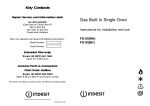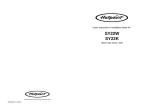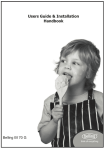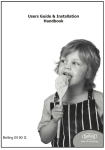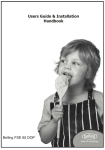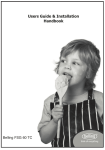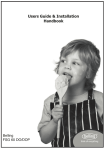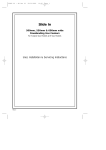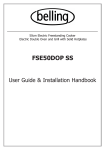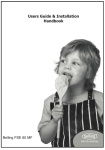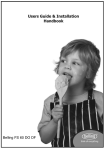Download Belling BI60SOXL Technical data
Transcript
Belling BI 60 G If you smell gas: Do not try to light any appliance. Do not touch any electrical switch. Call the Gas Emergency Helpline at TRANSCO on: 0800 111999 IMPORTANT NOTICE Please note the cooling fan fitted to this appliance is an integral part of its safety and functionality. When the appliance is installed care must be taken that the cooling fans performance is not impeded by any objects coming into contact with it. (Installation pipes, leads etc) Care must also be taken that there is sufficient air flow at the rear of the appliance for the cooling fan to run at its optimum efficiency. (Particularly Built In appliances) See clearance dimensions in the installation section of the booklet. During use the Appliance must never be disconnected from the Mains supply as this will seriously affect the safety and performance of the appliance, particularly in relation to surface temperatures becoming hot and gas operated parts not working efficiently. The cooling fan is designed to run on after the control knob has been switched off to keep the front of the appliance and the controls cool until the appliance has naturally cooled itself. The appliance must be installed (and serviced) by a GAS SAFE registered approved installer or a person competent to ensure that the installation is in accordance with “The Gas Safety (Installation and Use) Regulations 1994”, and the “The Gas Safety (Installation and Use) (Amendment) Regulations 1996”. Failure to comply with these Regulations is a criminal offence. Contents User Section . . . . . . . . . . . . . . . . . . . . . . . . . . . . . . . . . . . . . . . 3 -23 Introduction . . . . . . . . . . . . . . . . . . . . . . . . . . . . . . . . . . . . . . . . . . . . . . . . . 2 Be Safe - Not Sorry. . . . . . . . . . . . . . . . . . . . . . . . . . . . . . . . . . . . . . . . . . . . 5 Using the Grill . . . . . . . . . . . . . . . . . . . . . . . . . . . . . . . . . . . . . . . . . . . . . . . 6 Using the Oven . . . . . . . . . . . . . . . . . . . . . . . . . . . . . . . . . . . . . . . . . . . . . . 8 Oven ignition . . . . . . . . . . . . . . . . . . . . . . . . . . . . . . . . . . . . . . . . . . . . . . . . 9 Oven baking guide. . . . . . . . . . . . . . . . . . . . . . . . . . . . . . . . . . . . . . . . . . . 10 Roasting guide . . . . . . . . . . . . . . . . . . . . . . . . . . . . . . . . . . . . . . . . . . . . . . 11 Slow cooking, Frozen & Chilled food . . . . . . . . . . . . . . . . . . . . . . . . . . . . . . 12 Roasting Turkey . . . . . . . . . . . . . . . . . . . . . . . . . . . . . . . . . . . . . . . . . . . . . 13 Traditional Fruit cakes . . . . . . . . . . . . . . . . . . . . . . . . . . . . . . . . . . . . . . . . . 13 Automatic cooking . . . . . . . . . . . . . . . . . . . . . . . . . . . . . . . . . . . . . . . . . . . 14 Programmer / clock . . . . . . . . . . . . . . . . . . . . . . . . . . . . . . . . . . . . . . . . . . 15 Cleaning . . . . . . . . . . . . . . . . . . . . . . . . . . . . . . . . . . . . . . . . . . . . . . . . . . 19 Installation Instructions . . . . . . . . . . . . . . . . . . . . . Regulations & Standards, Ventilation requirements . . . . . . . . Step 1: Prepare installation . . . . . . . . . . . . . . . . . . . . . . . . Step 2: Connect to gas supply . . . . . . . . . . . . . . . . . . . . . . Step 3: Connect to electricity supply . . . . . . . . . . . . . . . . . . Step 4: Secure appliance into housing unit . . . . . . . . . . . . . Step 5: Commissioning . . . . . . . . . . . . . . . . . . . . . . . . . . . . . . . . . . . 22 ............. ............. ............. ............. ............. ............. 28 22 23 25 26 27 28 Technical Data . . . . . . . . . . . . . . . . . . . . . . . . . . . . . . . . . . . . . . . 29 Belling Customer Care. . . . . . . . . . . . . . . . . . . . . . . . . . . . Back Page Please keep this handbook for future reference, or for anyone else who may use this appliance. 1 Introduction Gas & Electrical connection We hope that the following information will help you to familiarise yourself with the features of the appliance, and to use it successfully and safely. Please refer to installation instructions for the Gas & Electrical Safety Regulations and the Ventilation Requirements. In your own interest, and that of safety, it is the law that all gas appliances be installed by a competent person who will ensure that the installation is in accordance with “The Gas Safety (Installation & Use) Regulations”, & the “The Gas Safety (Installation & Use) (Amendment) Regulations. Failure to comply with these Regulations is a criminal offence. Our policy is one of constant development and improvement. Strict accuracy of illustrations and specifications is not guaranteed. Modification to design and materials may be necessary subsequent to publication. This appliance must be installed in accordance with the regulations in force and only in a well ventilated space. Read the instructions before using or installing this appliance. Gas Safe registered installers undertake to work to satisfactory standards. Disconnection of gas and electric appliances should always be carried out by competent persons. Your 1st Year Guarantee To fulfil the conditions of your guarantee, this appliance must be correctly installed and operated, in accordance with these instructions, and only be used for normal domestic purposes. Warning: This appliance must be earthed. In the event of a power cut 1. Switch off the electricity to the appliance at the socket. Please note that the guarantee, and Service availability, only apply to the UK and Republic of Ireland. 2. When the power returns, see the ‘Programmer / Clock’ section to ‘Set the time of day’. The Gas Consumer Council (GCC) is an independent organisation which protects the interests of gas users. If you need advice, you will find the telephone number in your local telephone directory under Gas. 2 Introduction The cooling fan Switch the appliance off at the mains and contact Customer Care. The cooling fan helps to keep the exterior cool during normal use. When a burner is operated, you should hear the cooling fan switch on automatically and be able to feel air evacuating from the appliance vents just below the fascia. The cooling fan will continue to operate for approximately 10 minutes after turning off the burners. This is normal. Continued use of the appliance without it being serviced could result in excessive temperatures being generated, which in turn could reduce the life of certain components. Ventilation The use of a gas cooking appliance results in the production of heat and moisture in the room in which it is installed. Ensure that the kitchen is well ventilated; keep natural ventilation holes open or install a mechanical ventilation device (mechanical ventilator). If there is no such indication that the fan is operating, the appliance will require servicing. DO NOT USE THE APPLIANCE UNTIL IT HAS BEEN SERVICED. Switch the appliance off at the mains and contact Customer Care. Prolonged intensive use of the appliance may call for additional ventilation, for example opening a window, or more effective ventilation, for example increasing the level of mechanical ventilation where present. For your safety This appliance has a built in safety device to isolate the gas and electric supplies to various components in the event of fan failure. This appliance is not connected to a combustion products evacuation device. It must be installed and connected in accordance with current installation regulations. Particular attention must be given to the relevant regulations regarding ventilation. If the programmer/clock and lights do not function, and the ignition system stops working, the safety device has operated. Within an hour, the safety device will reset itself and the programmer /clock display will flash. Reset the time of day as detailed in this handbook. If when a burner control is turned on, the fan does not operate in the normal way, then the appliance will require servicing. DO NOT USE THE APPLIANCE UNTIL IT HAS BEEN SERVICED. 3 Introduction Glass door panels To replace an oven light bulb To meet the relevant Standards of Domestic cooking appliances, all the glass panels on this appliance are toughened to meet the fragmentation requirements of BS3193. This ensures that, in the unlikely event that a panel breaks, it does so into small fragments to minimise the risk of injury. WARNING - switch off the electricity supply to the appliance at the socket, to avoid the risk of electric shock. Wait until the oven is cool, then remove the oven shelves. The oven light is at the rear of the oven cavity. Unscrew the lens cover (turn anticlockwise). Unscrew the bulb and replace. Replace lens cover. Please take care when handling, using or cleaning all glass panels as any damage to the surfaces or edges may result in the glass breaking without warning or apparent cause at a later date. Should any glass panel be damaged, we strongly recommend that it is replaced immediately. Please note that the oven light bulb is not covered by guarantee. Environmental Protection We are committed to protecting the environment and operate an Environmental Management System which complies with BS EN ISO 14001. Before using the appliance for the first time, remove any protective polythene film and wash the oven shelves in hot soapy water to remove their protective covering of oil. Even so, when you first switch on the oven or grill you may notice a smell and some smoke. Disposal of packaging ! All our packaging materials are recyclable and environmentally friendly. ! Please help us to protect our environment by disposing of all packaging in an environmentally friendly manner. Condensation When hot and cold air meet, condensation forms. The outer door is air cooled and the inner door gets hot, so some condensation might form; this is normal and will disappear within 10 - 15 minutes. ! Please contact your local authority for the nearest recycling centre. Caution: Packaging materials can pose a risk of suffocation - keep away from children. 4 Be Safe - Not Sorry When you are cooking, keep children away from the vicinity of the appliance. ! Always use oven gloves when removing hot food / dishes from the oven or grill. The oven / grill and utensils will be very hot when in use. This product is designed as a domestic cooking appliance for the preparation and cooking of domestic food products, and should not be used for any other purpose. ! When opening the appliance door, take care to avoid skin contact with any steam which may escape from the cooking. ! Remove all packaging from the appliance before using for the first time. ! Do not use foil on oven shelves or allow it to block the oven flue, as this creates a fire hazard, and prevents heat circulation. ! Make sure you read and understand the instructions before using the appliance. ! When cooking heavy items - eg; turkeys - do not pull the oven shelf out with the item still on the shelf. ! Keep electrical leads short so they do not drape over the appliance or the edge of the worktop. ! Switch off the electricity supply before replacing the oven light bulb to avoid the risk of an electric shock. ! Keep all flammable materials (such as curtains, furnishings & clothing) away from the appliance. All installation, servicing and maintenance work must be carried out by a competent person who will comply with current Regulations, Standards and Requirements. ! Parts of the appliance may be hot during or immediately after use. Allow sufficient time for the appliance to cool after switching off. Warning: This appliance must be earthed. ! Do not drape tea towels over the flue vents or doors, as this creates a fire hazard. When you have finished cooking check that all controls are in the off position. ! Do not use aluminium foil to cover the grill pan, or put items wrapped in foil under the grill, as this creates a fire hazard. As with all gas appliances, it is recommended that your appliance is serviced regularly. ! Never use the appliance for heating a room. ! Do not use the oven with the door inner glass panel removed (glass oven doors only). 5 Using the Grill Caution: Accessible parts may be hot when the grill is used, young children should be kept away. Detachable grill pan handle Grill operation Important: The door must be fully open when the grill is used. Open the door. Push in and turn the control knob clockwise to the grill position. To switch off, turn the control knob anti-clockwise to return it to the “"” off position. Place the handle over the edge of the grill pan, at the narrow side edges. Slide the handle to the centre, and locate between the handle position indicators. Aluminium foil Never cover the grill pan or grill trivet with cooking foil, or allow fat to build up in the grill pan, as this creates a fire hazard. The handle should be removed from the pan during grilling, to prevent overheating. The handle is designed for removing / inserting the grill pan under the grill when grilling. If cleaning the grill pan when it is hot, use oven gloves to move it. Do not use the handle to pour hot fats from the grill pan. Food for grilling should be positioned centrally on the trivet. 6 Using the Grill Using the grill Push the grill pan towards the back of the shelf, to position it under the grill. Variation in grilling can be achieved by moving the grill pan up or down. The speed of grilling can also be controlled by selecting a higher or lower shelf position. Always use the top shelf position for fast toasting. For toasting, and for grilling foods such as bacon, sausages or steaks, use a higher shelf position. For thicker foods such as chops or chicken joint pieces, use a middle to low shelf position. The grill trivet, inside the grill pan, can be inverted to give a high or low position, or it may be removed. When you have finished grilling, check that the control knob is returned to the off position. 7 Using the Oven When you are cooking, keep children away from the vicinity of the oven. trays and roasting tins that should be used are as follows; Baking tray 350mm x 280mm This size of baking tray will hold up to 16 small cakes. Notes In the event of the flame being accidentally extinguished, the flame will automatically re-light, owing to the automatic re-ignition system. Roasting tin 370mm x 320mm We recommend that you use good quality cookware. Poor quality trays and tins may warp when heated, leading to uneven baking results. If it is found over a period of time that the oven becomes hotter when used at a particular gas mark, the thermostat may need to be replaced. Preheating The oven must be preheated for 15 minutes when reheating frozen or chilled food, and we recommend preheating for yeast mixtures, batters, soufflés and whisked sponges. As part of the cooking process, hot air is expelled through a vent at the top of the oven(s). When opening the oven door, care should be taken to avoid any possible contact with potentially hot air, since this may cause discomfort to people with sensitive skin. We recommend that you hold the underneath of the oven door handle. If you are not preheating the oven, the cooking times in the Baking Guide may need to be extended, as they are based on a preheated oven. Oven furniture Oven shelves The oven shelf must be positioned towards the rear of the oven, with the upstand facing upwards. Position baking trays and roasting tins on the middle of the shelves, and leave one clear shelf position between shelves, to allow for circulation of heat. Baking tray and roasting tins For best cooked results and even browning, the maximum size baking 8 Using the Oven Oven ignition Ignition Baking guide - hints Push in and turn the main oven control knob anti clockwise to the ‘FULL ON’ position (gas mark 9). The ignition system will spark automatically. Push in the control knob to ignite the gas. The sparking will stop. If after 15 seconds, the burner has not lit, turn off the oven and leave the compartment door open. Wait at least one minute before a further attempt to ignite the burner. To protect a very rich fruit cake during cooking, tie 2 layers of brown paper around the tin. Cooking times for pastry dishes depend on the size and type of cooking dish and also the filling. When cooking 2 trays of items, remove the top item when it is cooked and raise the lower item to the higher shelf to finish cooking, or where additional browning of the base is required - eg; pies and pastries interchange part way through cooking. Do not hold the control knob in for more than 15 seconds. Turn the control knob clockwise to the required setting. To turn off, return the control knob to the “off” position. Zones of heat The temperature at the centre of the oven corresponds with the selected Gas Mark and is slightly higher towards the top of the oven and slightly lower towards the oven base. These zones of heat can be useful as different dishes requiring different temperatures may be cooked at the same time - eg; the temperature at the oven base is suitable for cooking baked vegetables, baked fruit, milk pudding, etc, and for warming bread rolls, soup, coffee, or ovenproof plates and dishes. 9 Using the Oven Baking guide Dish Recommended gas mark Shelf position Approximate cooking times Scones Meringues 7 “S” (slow setting) top to middle middle to bottom 8 - 15 mins 2 - 3 hours 5 5 6 4 middle middle middle middle 15 20 10 20 4 3 3 2 or 3 middle middle to top middle to top middle to top 20 - 30 mins 1 - 11⁄4 hours 1 - 11⁄4 hours 21⁄2 - 3 hours 1 or 2 3 middle to bottom middle to bottom depends on recipe 2 - 21⁄2 hours Pastry Flaky / Puff Shortcrust Choux Plate tarts 7 6 6 6 middle middle middle middle to to to to top top top top 15 15 15 30 Biscuits Nut brownies Brandy snaps Flapjacks Ginger nuts 6 4 4 4 middle middle middle middle to to to to bottom top top top 15 - 20 mins 7 - 18 mins 20 - 40 mins 10 - 20 mins Puddings (1l / 2 pint dish) Rice pudding Baked custard Bread and butter Hot soufflé Fruit crumble 2 3 3 4 6 middle middle middle middle middle to to to to to top top top top top 2 - 21⁄2 hours 1 - 11⁄4 hours 3 ⁄4 - 11⁄4 hours 35 - 50 mins 1 ⁄2 - 1 hours Cakes Small cakes Whisked sponge Swiss roll Victoria sandwich (2 x 180mm / 7”) Genoese sponge Madeira (180mm / 7”) Gingerbread Semi rich fruit cake (205mm / 8”) Christmas cake Dundee cake (205mm/8”) 10 to to to to top top top top - - 25 25 12 30 45 45 45 45 mins mins mins mins mins mins mins mins Using the Oven Roasting guide Notes: The times given in the roasting guide are only approximate, because the size and age of the bird will influence cooking times as will the shape of a joint and the proportion of the bone. ! When cooking stuffed meat or poultry calculate the cooking time from the total weight of the meat plus the stuffing. ! For joints cooked in foil or covered roasters, and for lidded casseroles, add 5 minutes per 450 g (1lb) to the calculated cooking time. Frozen meat should be thoroughly thawed before cooking. For large joints it is advisable to thaw overnight. Frozen poultry should be thoroughly thawed before cooking. The time required depends on the size of the bird - eg; a large Turkey may take up to 48 hours to thaw. ! Smaller joints weighing less than 1.25kg (21⁄2lb) may require 5 minutes per 450g (1lb) extra cooking time. ! Position the oven shelf so that the meat or poultry will be in the centre of the oven. Use of a trivet with a roasting tin will reduce fat splashing and will help to keep the oven interior clean. Alternatively, to help reduce fat splashing, potatoes or other vegetables can be roasted around the meat / poultry. ! It is recommended that the appliance is cleaned after open roasting. Cook in oven at gas mark 5 Approximate cooking time (preheated oven) Beef Rare Medium Well done 20 minutes per 450g (1lb), plus 20 minutes 25 minutes per 450g (1lb), plus 20 minutes 30 minutes per 450g (1lb), plus 30 minutes Lamb Medium Well done 25 minutes per 450g (1lb), plus 35 minutes 30 minutes per 450g (1lb), plus 30 minutes Pork 35 minutes per 450g (1lb), plus 35 minutes Poultry 20 minutes per 450g (1lb), plus 20 minutes 11 Using the Oven Cooking frozen & chilled foods Slow cooking ! Preheat the oven. ! Make sure that frozen foods are thoroughly THAWED before cooking. ! When cooking frozen or chilled foods, please follow the manufacturer’s instructions. If cooking more than one tray or item, cooking times may need to be increased. ! Do not slow cook joints of meat or poultry weighing more than 21⁄4 kg / 41⁄2lb. ! For roasting joints of meat or poultry and for pot roasts preheat the oven to Gas Mark 6 and cook for 30 minutes, then adjust the oven control to ‘S’ slow cook setting for the remainder of the cooking time. ! Please ensure that foods are piping hot before consumption. ! Always use the temperature setting stated on food packaging when cooking convenience food. ! Never overload the tray - eg; oven chips should be placed onto the baking tray in one even layer for satisfactory cooking. ! Always use the top half of the oven when slow cooking. ! Slow cooking times will be about three times as long as conventional cooking times. ! Follow the cooking times given on packaging but remember they are only intended as a guide and do not take individual preferences into account. ! Always cook frozen convenience foods straight from the freezer unless packaging advises otherwise. 12 Using the Oven Traditional fruit cakes Roast Turkey It should be remembered that ovens can vary over time, therefore cooking times can vary, making it difficult to be precise when baking fruit cakes. Roasting Turkey perfectly involves cooking two different types of meat the delicate light breast meat, which must not be allowed to dry out, and the darker leg meat, which takes longer to cook. It is necessary, therefore, to test the cake before removal from the oven. Use a fine warmed skewer inserted into the centre of the cake. If the skewer comes out clean, then the cake is cooked. The Turkey must be roasted long enough for the legs to cook, so frequent basting is necessary. The breast meat can be covered once browned. ! Do not attempt to make Christmas cakes larger than the oven can cope with; you should allow at least 25mm (1 inch) space between the oven walls and the tin. ! Turkey should be roasted at gas mark 4 for 20 minutes per 1lb, plus 20 minutes unless packaging advises otherwise. ! Always follow the temperatures recommended in the recipe. ! The Turkey can be open roasted, breast side down, for half of the cook time, and then turned over for the remainder of the cooking time. ! To protect a very rich fruit cake during cooking, tin, or tie 2 layers of brown paper around the tin. ! If the Turkey is stuffed, add 5 minutes per lb to the cooking time. ! We recommend that the cake tin is not stood on layers of brown paper, as this can hinder effective circulation of air. ! If roasting Turkey covered with foil, add 5 minutes per 1lb to the cooking time. To test if the Turkey is cooked, push a fine skewer into the thickest part of the thigh. If the juices run clear, the Turkey is cooked. If the juices are still pink, the Turkey will need longer cooking. ! Do not use soft tub margarine for rich fruit cakes unless specified in the recipe. ! Always use the correct size and shape of tin for the recipe quantities. 13 Using the Oven Semi-Automatic cooking in the main oven Important: Food is more susceptible to the growth of food poisoning organisms in warm conditions. If the weather is hot, either take care to ensure that food is not left standing in a warm oven, or avoid using the automatic cooking facility. The semi-automatic cooking facility is controlled by the programmer (see ‘Programmer/Clock’ section) and allows for the finish time to be set. If you know the cooking time of the dish that you are cooking, you can set this and the oven will automatically turn off when this time is reached. Do: ! Cover dishes with lids or foil to keep the food moist, prevent the transfer of odours and protect from possible contamination; the food can be uncovered towards the end of cooking to crisp and brown. Do not: ! Do not put food items (intended for automatic cooking) into a warm oven. Allow the oven to cool before setting to automatic cooking. ! Do not over-fill dishes containing liquids as they might boil over. ! Never leave food in the oven to cool slowly after cooking; serve immediately or refrigerate. 14 Programmer / Clock The clock on this product has two modes of operation, fully automatic or semi-automatic. This product is intended for use on the semi automatic mode only. If for some reason this mode has not already been pre-set, the following procedure should be used to set it to this mode:1. Turn the power off to the appliance for 30 seconds or more , then turn the power on. 2. Within the first 6 seconds of turning the power on, press the plus button for 1 second. 3. The operating mode “P2” can then be selected using the plus or minus buttons. 4. The clock has now been set to semiautomatic mode, any power fail situations will not change the selected mode. 15 Programmer / Clock The programmer buttons the second tone, etc. Releasing the button after the tone has sounded will automatically select that tone. minus plus Setting the minute minder The ‘function’ button in the centre is used for setting the minute minder and setting up the automatic cooking. See below for details. To set the time of day Press and release the function button. The minute minder bell symbol will appear and flash on the display. Use the plus and minus buttons to set the required alarm time. After setting, the display will revert to show the time of day and the bell symbol will stop flashing. Pressing the function button will display the minutes remaining. If the time has counted down to the last minue, the remaining seconds are shown. The tone will sound at the end of the time set. To cancel the tone, press the function button. When the power is turned on to the appliance, the time of day starts from 0.00. Press and release the (minus) and (plus) buttons simultaneously. Set the time of day, eg 2.00 with the and buttons while the ‘dot’ beween the hours and minutes is flashing. To select an alarm tone Press and hold the (minus) button to listen to the first tone. Release the button and press it again to listen to 16 Programmer / Clock Semi-automatic cooking For the instructions on how to use both of these functions, please see the following pages. There are two types of semi automatic cooking available on this appliance. The oven must be switched on, and in use to use either of these functions successfully. The Duration method allows you to set the oven for a specific length of time. If a dish needs 2 hours to cook, then it is possible for you to set the oven to turn off 2 hours later. This allows you to be sure that your food will be cooked for a set length of time and no longer. The End Time method allows you to enter a specific time when you would like the oven to switch off. If you wish to leave the oven unattended, then it offers peace of mind that the oven will have turned itself off at the set time. However, once the program is set then it cannot be adjusted. Extra time cannot be added, nor can the end time be extended. To cancel the semi automatic programs, press both the Plus and Minus buttons together. This can be done at any time during the cooking process. Then if necessary, re program. 17 Programmer / Clock 1. The Duration method Semi-automatic cooking The Duration method # Press the Function button twice,(1) which will skip past the Minute Minder. Function The LED display will flash the word ‘dur’, (2) and the ‘A’ will flash on the left hand side of the display. # 2. # Use the Plus and Minus buttons to set the length of time you want to cook for.(3) This must be done within 5 seconds or the time of day will show again. Once this is done the oven automatically switch off once the has elapsed, and the alarm sound. To switch off the alarm, press button. To view any remaining press the function button twice 3. Function will time will 4. The End Time method any time The End Time method Function Press the Function button three times, which will skip past the Minute Minder and the Duration programmer. (4) # The LED display will flash the word ‘End’ and the ‘A’ will flash on the left hand side of the display. (5) # Use the Plus and Minus buttons to select the time the oven is required to turn off. (6) 5. # Once this is done the oven will turn itself off at the time you have selected. To switch off the alarm, press any button. 6. Function 18 Cleaning Caution: Any cleaning agent used incorrectly may damage the appliance. Enamel surfaces OVEN CAVITY, GRILL PAN Some cooking operations generate a considerable amount of grease. This, combined with spillage, can become a hazard if allowed to accumulate on the appliance through lack of cleaning. In extreme cases this may amount to misuse of the appliance and could invalidate your guarantee. Caution: Most types of cleaning agent will damage these surfaces. Only use a few drops of washing up liquid in hot water. Wipe the surfaces with a clean cloth wrung out in hot soapy water - if larger splashes of fat do not readily disappear, scrub the area with a nylon brush or nylon pan scourer and hot soapy water. Rinse well and heat the oven to dry the surfaces. It is recommended that the appliance is cleaned after open roasting. Do not use caustic, corrosive or abrasive cleaning products, products containing bleach, coarse wire wool or any hard implements, as they will damage the surfaces. All parts of the appliance can be safely cleaned with a cloth wrung out in hot soapy water. Painted, plastic and metal finish parts (if fitted) HANDLES, METAL FASCIA ROASTING TIN If you do a lot of open roasting, or roast at temperatures above 200˚C, we recommend regular cleaning. Use of a trivet in a roasting tin when roasting will help reduce fat splashing. Always let the appliance cool before cleaning. DOOR & PANEL, CONTROL KNOBS Only use a clean cloth wrung out in hot soapy water. 19 Cleaning Glass parts FACIA PANEL & Important: if the inner door glass panel is removed for cleaning, it must be replaced the right way up as shown, and pushed fully in to the stop position. DOOR PANELS Use a mild cream cleaner. Rinse thoroughly and dry with a soft cloth. Do not use abrasive cleaners or polishes. To remove the glass panel for cleaning, open the door to the door stop position (about 30° open), hold the top and bottom edges of the panel and slide out. Note that if the door is opened fully when removing the inner door glass panel, the door may spring shut. slide in this way up Chrome plated parts OVEN SHELVES & OVEN SHELF RUNNERS, GRILL PAN TRIVET 30° Do not use abrasives or polishes. Use a moist soap pad. Shelf runners can be removed for cleaning. Grasp the runners, and slide out of the hanging holes as shown. Note: These items may also be cleaned in a dishwasher. Door stop position 20 Cleaning Stainless Steel surfaces (stainless steel finish models only) FACIA PANEL, HANDLES, DOOR CLADDING Only use a clean cloth wrung out in hot soapy water, and dry with a soft cloth. Stubborn marks can be removed using stainless steel cleaner. We recommend that you clean the whole of the stainless steel area to maintain a uniform finish. Supplies can be purchased from the Customer Care Centre. Do not use undiluted bleach or any products containing chlorides as they can permanently damage the steel. Extra care should be taken when cooking food in salted water. Some foods are corrosive - eg; vinegar, fruit juices and especially salt - they can mark or damage stainless steel if they are left on the surface. Turn off and wipe any spillage immediately, taking care to avoid skin contact with any hot surface or spillage. Sharp objects can mark the surface of stainless steel, but marks will become less noticeable with time. To maintain the finish of the stainless steel, or to remove any greasy marks, wipe the stainless steel surface sparingly with a minimum amount of Baby Oil and kitchen paper. Do not use cooking oils, as these may contain salt, which can damage the stainless steel surface. 21 Installation Instructions Before you start: Please read the instructions. Planning your installation will save you time and effort. accordance with all local gas and electrical regulations. In the Republic of Ireland, Installers should refer to IS813 Domestic Gas Appliances. Prior to installation, ensure that the local distribution conditions (nature of the gas and gas pressure) and the adjustment of the appliance are compatible. The adjustment conditions are stated on the data badge. Ventilation Requirements The room containing the appliance should have an air supply in accordance with BS 5440: Part 2. • All rooms require an openable window, or equivalent, and some rooms will require a permanent vent as well. • For room volumes up to 5m3 an air vent of 100cm2 is required. • If the room has a door that opens directly to the outside, or the room exceeds 10m3, NO AIR VENT is required. • For room volumes between 5m3 and 10m3 an air vent of 50cm2 is required. • If there are other fuel burning appliances in the same room, BS 5440: Part 2 should be consulted to determine the air vent requirements. • This appliance must not be installed in a bed sitting room of less than 20m3 or in a bathroom or shower room. Windows and permanent vents should therefore not be blocked or removed without first consulting a Gas Safe gas installer. This appliance is not connected to a combustion evacuation device. It shall be installed and connected in accordance with current installation regulation. Particular attention shall be given to the relevant requirements regarding ventilation. In your own interest and that of safety, it is the law that all gas appliances be installed and serviced by competent persons. Gas Safe registered installers undertake to work to satisfactory standards. Where regulations or standards have been revised since this handbook was printed, always use the latest edition. In the UK the regulations and standards are as follows: 1. Gas Safety Regulations (Installation and Use). 2. Building Regulations - Issued by the Department of the Environment. 3. Building Standards (Scotland) (Consolidated) - Issued by the Scottish Development Department. 4. The current I.E.E. Wiring Regulations. 5. Electricity at Work Regulations. 6. BS 6172 Installation of Domestic Gas cooking Appliances 7. Installation & Servicing Instructions for this appliance. In the Republic of Ireland, refer to relevant Irish Standards for correct ventilation requirements. Failure to install appliances correctly is dangerous and could lead to prosecution.This appliance is not connected to a combustion products evacuation device. It shall be installed and connected in accordance with current installation regulations. Particular attention shall be given to the relevant requirements regarding ventilation. For installation in countries other than the UK, the appliance must be connected in 22 Installation Instructions Step 1: Prepare installation Do not lift the appliance by the door handle. Whilst every care is taken to eliminate burrs and raw edges from this product, please take care when handling - we recommend the use of protective gloves during installation. Please note that the weight of this appliance is approximately 31kg (unpacked). Take care when lifting it into the housing unit - always use an appropriate method of lifting. Housing dimensions The appliance is designed to fit into a standard 600mm wide housing unit with minimum internal dimensions as shown. Remove the fixing screws from the polythene bag on the top of the appliance, but leave the appliance in the base tray packaging until you are ready to install it. If this appliance is to be installed near to a corner where the adjacent cabinets run at right angles forward of the appliance, there must be a gap of at least 90 mm between the appliance and the cabinets, to prevent overheating of the cabinets. 591mm is to the underside of the worktop when the appliance is built under, or to the underside of the panel above, when the appliance is installed into a tall housing unit. 23 Installation Instructions i) Important: Do not modify the outer panels of this appliance in any way. When installed in a typical 600mm deep built in housing unit, the false back should be removed from the housing unit to provide the necessary depth for installation. Ensure that you route all mains electrical cables and flexible tubing well clear of any adjacent heat source, such as an oven, grill or hob. ii) When the false back is removed, it is normally the case that the support shelf for the appliance leaves a gap between the back edge and the wall of approximately 80mm. Ensure that all pipe work is of the correct rating for both size and temperature. iii) If no gap occurs between the back edge of the shelf and the wall behind the unit, we recommend that a gap of at least 30mm is made by shortening the shelf. Installing the appliance under a worktop Where the appliance is installed under a worktop, with a hob installed above it, the installation instructions for the hob must be read in conjunction with these instructions. iv) When installing the appliance below a worktop, there must be a minimum ventilation area of 60cm2 below the appliance, in either area (1) or (2), as indicated below. There must be a 5mm gap between the front top edge of the oven and the underside of the worktop. 24 Installation Instructions Step 2: Connect to gas supply 4. Flexible connections should comply with BS 669. Parts of the appliance likely to come into contact with a flexible connector have a temperature rise of less than 70˚C. 1. The inlet to the appliance is ISO 7 - Rp 1⁄2” internal thread situated towards the top right hand rear corner. 2. Fit the bayonet connection to the wall in the shaded area as shown. 5. Rigid connections must be accessible to disconnect for servicing. Cut a 150mm square hole in the right hand rear corner of the support shelf for the supply pipe. The shaded area shown is applicable to installations in minimum depth cabinets. If more room is available, bayonet fixing area can extended, provided that flexible tube does not obscure fan intake. the be the the 6. Make sure all connections are gas sound. 60mm rear wall 60 mm 60mm square 3. Use a 900mm - 1125mm length of flexible connector. The flexible connector shall be fitted such that it cannot come into contact with a moveable part of the housing unit (eg; drawer) and does not pass through any space susceptible of becoming congested. Make sure that the flexible connector does not block the cooling fan inlet. 25 Installation Instructions Step 3: Connect to the electricity supply As the colours of the wires in the mains lead for the appliance may not correspond with the coloured markings identifying the terminals in your spur box, proceed as follows: This appliance must be connected by a competent person, using fixed wiring via a double pole switched fused spur outlet, with a contact separation of 3mm at all poles. 1. The wire which is coloured green and yellow must be connected to the terminal marked E (Earth) or coloured green. Use a 13 amp fuse. We recommend that the appliance is connected by a qualified electrician, who will comply with the I.E.E. and local regulations. Warning: earthed. 2. The wire which is coloured blue must be connected to the terminal marked N (Neutral) LOAD or coloured Black. This appliance must be 3. The wire which is coloured brown must be connected to the terminal marked L (Live) LOAD or coloured Red. The wires in the mains lead are coloured in accordance with the following code: Green & Yellow = earth, Blue = neutral, Brown = live. If the supply cord is damaged, obtain a special cord from the Customer Support Helpline, which must be fitted by a qualified person. Typical example of a double pole fuse spur outlet Earth Live N ON SUPPLY L LOAD L FUSE 13 ~ N LOAD 250 USE A 13 AMP FUSE Neutral 26 Cable Installation Instructions Step 4: Secure appliance into housing unit There are 4 black no 8 x 25mm long chipboard screws for securing appliance to cabinet. Insert appliance into cabinet and secure - open the oven door and screw the 4 screws through the holes in the front frame. Note: The unit housing the appliance must be appropriately fixed. 27 Installation Instructions Step 5: Commissioning Oven Ignition Pressure test point Push in and turn the main oven control knob anti clockwise to the ‘FULL ON’ position (gas mark 9). The ignition system will spark automatically. Push in the control knob to ignite the gas. The sparking will stop. If after 15 seconds, the burner has not lit, turn off the oven and leave the compartment door open. Wait at least one minute before a further attempt to ignite the burner. Use the oven burner. From inside the oven remove the burner cowl. Remove the small screw at the LHS of the burner cradle. Slide the burner to the left to access the injector. Connect suitable T-piece (incorporating a 115 injector) to the injector. Connect manometer to the T-piece, and turn oven control to full on to check pressure. Replace in reverse order. Do not hold the control knob in for more than 15 seconds. Burner aeration Turn the control knob clockwise to the required setting. All burners have fixed aeration and no adjustment is possible. To turn off, return the control knob to the “off” position. Pressure setting Grill Cat I2H Natural Gas G20 @ - 20mbar 1. The door must be open for grilling. Electrical systems check 2. Push in and turn the control knob clockwise to the grill symbol. In the event of an electrical fault the preliminary electrical system check (earth continuity, short circuit, polarity and resistance to earth) must be carried out. Before leaving the installation Show the customer how to ignite the oven and operate the grill and give them this handbook. Thank you. 28 Technical Data Data badge Lower part of front frame and rear of appliance. Grill Nominal Rate Qn Type of gas This cooker is factory set for use on Natural Gas only, as specified on the appliance data badge. Bray type burner, sheet steel body, stainless steel flame strip 1.8kW Oven Nominal Rate Qn Injector Spark gap Thermostat bypass Gas category Natural Gas - I2H 2.5kW 115 3 - 4mm 50 Oven injector - If the injector is removed or replaced for any reason, it is mandatory to apply Hylomar PL32 or Plasticol X10 sparingly to the thread prior to (re) fitting. Pressure setting Natural Gas G20 @ 20mbar Appliance class Class 3, built in oven and grill Maximum heat input ∑ Qn 2.5kW Ignition Mains operated re-ignition generator Countries of destination GB - Great Britain Electrical supply 220 - 240V ~ 50Hz 29 Belling Customer Care Please keep this handbook in a safe place as the information inside may be of use should you sell, or pass on the appliance. Please fill in the model number and serial number in the spaces provided below as they will assist us should you need to call. 0844 815 3746 When you dial this number you will hear a recorded message and be given a number of options. This indicates that your call has been accepted and is being held in a queue. Calls are answered in strict rotation as our Customer Care Representatives become available. Enter appliance numbers here for future reference: Model No 4 4 4 Serial No These numbers can be found on your appliances data badge. Outside the UK and Northern Ireland, refer to your local supplier. Stoney Lane, Prescot, Merseyside. L35 2XW. 08 27431 03 © 11.2010
































